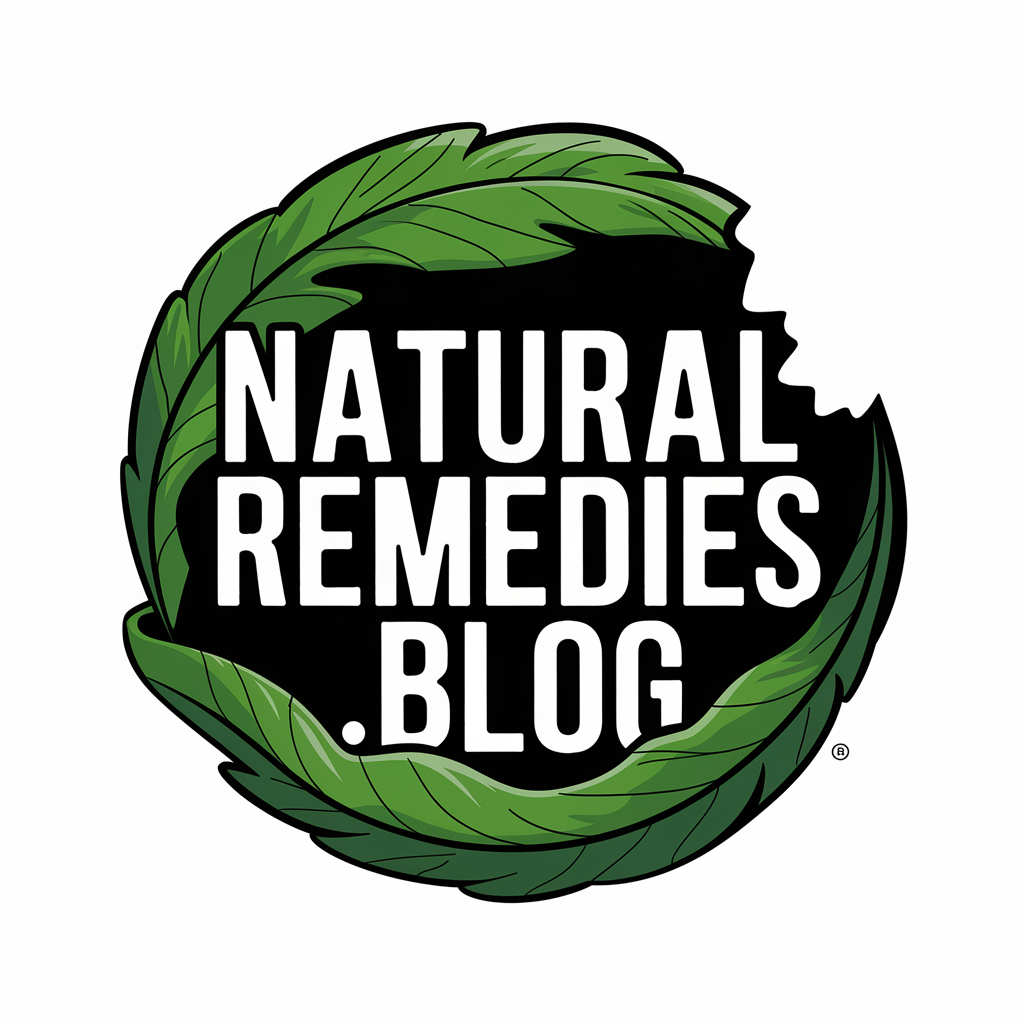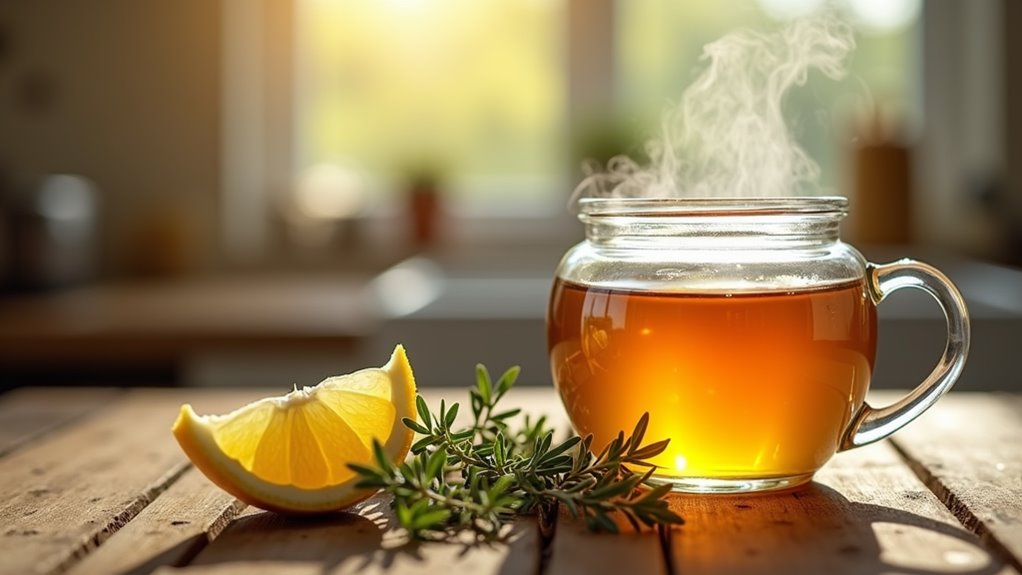What Are 7 Natural Cough Remedies That Actually Taste Good.
Dealing with a nagging cough but can’t stomach another dose of syrupy medicine? These 7 natural cough remedies use ingredients like honey, ginger, and dark chocolate to soothe your throat while actually tasting delicious. Most take less than 5 minutes to prepare using pantry staples you probably already have, and they’re backed by real science showing compounds like bromelain and theobromine help calm coughs naturally. Ready to ditch the drugstore bottle? Let me show you how simple this is.
Honey and Lemon Tea
[SUBHEADING IMAGE SLOT 0]
Honey and lemon tea combines two ingredients with distinct therapeutic properties that may help alleviate cough symptoms. Honey contains antimicrobial compounds and antioxidants that can coat your throat, potentially reducing irritation. Research suggests it’s particularly effective for nighttime coughs in children over one year old.
Lemon provides vitamin C and citric acid, which may help thin mucus secretions.
To prepare this remedy, you’ll mix one to two tablespoons of honey with freshly squeezed lemon juice in warm water. The warmth itself can soothe throat discomfort. For enhanced effectiveness, you can combine honey with chamomile tea to create a calming bedtime blend. Among natural cough remedies, this combination stands out for its palatability and accessibility. However, you shouldn’t give honey to infants under 12 months due to botulism risk. If your cough persists beyond three weeks, consult your healthcare provider.
Ginger Syrup With Maple
When combined with maple syrup, ginger creates a potent natural cough suppressant that leverages the anti-inflammatory properties of gingerol compounds. You’ll need fresh ginger root (about 2 inches), which contains higher concentrations of active compounds than dried varieties. Simmer sliced ginger in 1 cup of water for 15 minutes, then strain and mix with 2 tablespoons of pure maple syrup. The maple provides antimicrobial properties while masking ginger’s sharp taste.
Take 1-2 teaspoons every 4 hours during acute cough episodes. Studies suggest gingerol inhibits airway inflammation and reduces cough reflex sensitivity. For enhanced effectiveness, you can add raw honey, which offers antibacterial benefits and soothes irritated throat tissue. However, you shouldn’t exceed 4 grams of ginger daily, as higher doses may cause digestive discomfort. Consult your healthcare provider if you’re taking blood thinners, as ginger affects platelet function.
Pineapple Juice
[SUBHEADING IMAGE SLOT 2]
Bromelain, a proteolytic enzyme found exclusively in pineapple, offers scientifically-supported benefits for cough relief that differ from ginger’s anti-inflammatory approach. This enzyme helps thin mucus secretions, making them easier to expel from your respiratory tract.
You’ll find the highest bromelain concentration in fresh pineapple juice—canned varieties contain markedly less due to heat processing. For therapeutic effects, you need approximately 8 ounces of fresh juice daily, though research hasn’t established definitive dosing protocols.
Pineapple’s vitamin C content (78.9mg per cup) provides additional immune support during respiratory infections. The natural sweetness makes it palatable without added sugars.
However, you shouldn’t consume pineapple juice if you’re taking blood thinners, as bromelain affects platelet function. It may also interact with certain antibiotics. Like elderflower’s antiviral compounds, bromelain demonstrates medicinal properties that complement conventional cold and cough treatments.
Dark Chocolate
While it may seem unconventional, dark chocolate contains theobromine, an alkaloid compound that’s demonstrated superior cough-suppressing effects compared to codeine in clinical trials. This naturally occurring substance works by suppressing vagus nerve activity, which triggers your cough reflex.
You’ll want to choose dark chocolate with at least 70% cacao content to maximize theobromine concentration. The effective dose appears to be approximately 1,000 mg of theobromine, equivalent to roughly 50 grams of dark chocolate.
However, you should consider the caloric and caffeine content before consuming therapeutic amounts regularly. Dark chocolate also contains modest amounts of magnesium and iron. If you’re sensitive to stimulants or have gastroesophageal reflux, consult your healthcare provider, as chocolate can worsen these conditions. For additional throat comfort, you can pair dark chocolate with ginger and turmeric tea sweetened with raw honey to enhance its soothing effects.
Licorice Root Tea
[SUBHEADING IMAGE SLOT 4]
Licorice root tea contains glycyrrhizin, a compound that research suggests can help coat and soothe irritated throat tissues while reducing cough frequency.
You’ll want to steep one to two teaspoons of dried licorice root in hot water for 10-15 minutes to extract the beneficial compounds effectively. The root’s natural sweetness comes from glycyrrhizin being 50 times sweeter than sugar, so you won’t need additional sweeteners.
Like marshmallow root tea, licorice root provides a protective coating in the throat that helps reduce irritation and calm persistent coughs.
Natural Soothing Properties Explained
For centuries, herbalists have turned to licorice root as a time-tested remedy for respiratory irritation, and modern research has begun to validate this traditional use. The root contains glycyrrhizin, a compound that demonstrates anti-inflammatory and demulcent properties, meaning it coats and soothes your irritated throat tissues.
Studies suggest that licorice’s active constituents may help reduce cough frequency by calming bronchial spasms and thinning mucus secretions.
You’ll find that licorice root also contains flavonoids and saponins that support your respiratory system’s natural defense mechanisms. However, you should exercise caution with prolonged use, as glycyrrhizin can elevate blood pressure and interact with certain medications. Limit consumption to two weeks maximum, and consult your healthcare provider if you’re pregnant, hypertensive, or taking prescription drugs.
Brewing the Perfect Cup
Understanding licorice root‘s therapeutic compounds naturally leads to proper preparation methods that maximize their benefits. You’ll need one teaspoon of dried licorice root per cup of water. Bring water to a boil, then reduce heat and simmer the root for 10-15 minutes—this extended steeping extracts glycyrrhizin and flavonoids more effectively than quick steeping. Strain thoroughly and consume while warm for ideal soothing effects.
Don’t exceed three cups daily, as glycyrrhizin can elevate blood pressure and affect potassium levels with excessive intake. If you’re pregnant, have hypertension, or take cardiac medications, consult your healthcare provider before use. The tea’s naturally sweet flavor means you won’t need additional sweeteners, making it particularly appealing for cough relief without added sugars that can irritate throats.
Sweet Flavor Without Sugar
While most herbal teas require honey or sweeteners to improve palatability, licorice root‘s natural glycyrrhizin provides approximately 50 times the sweetness of sugar without adding calories or triggering blood glucose spikes. This compound also delivers demulcent properties that coat irritated throat tissues while reducing cough frequency.
You’ll find licorice root particularly beneficial if you’re managing diabetes or reducing sugar intake. The root contains flavonoids and saponins that demonstrate expectorant effects, helping mobilize mucus from respiratory passages.
However, you shouldn’t consume licorice root tea daily for extended periods. Glycyrrhizin can elevate blood pressure and deplete potassium levels when used excessively. Limit consumption to two weeks maximum, and avoid it entirely if you have hypertension, kidney disease, or take cardiac medications.
Cinnamon and Honey Mixture
[SUBHEADING IMAGE SLOT 8]
Since ancient times, traditional medicine systems have employed cinnamon and honey as a combined remedy for respiratory discomfort, though modern scientific evidence supporting this practice remains limited. You’ll find that cinnamon contains cinnamaldehyde, a compound with antimicrobial properties that may help address bacterial throat infections.
Honey’s viscosity coats your throat tissues, potentially reducing irritation-triggered coughing reflexes.
To prepare this mixture, you can combine one tablespoon of raw honey with one-quarter teaspoon of ground cinnamon. However, you shouldn’t give honey to children under twelve months due to botulism risk. The mixture’s effectiveness likely stems from honey’s soothing properties rather than any proven synergistic effect between ingredients.
For enhanced therapeutic benefits, you can add fresh lemon juice and grated ginger to create a synergistic effect that targets upper respiratory complaints more effectively. If your cough persists beyond two weeks or worsens, you’ll need professional medical evaluation.
Marshmallow Root With Peppermint
Marshmallow root contains mucilage compounds that form a protective gel-like coating over irritated throat tissues, which may help reduce cough triggers.
When combined with peppermint, you’ll get menthol’s cooling sensation alongside improved palatability.
You can prepare this remedy by steeping one tablespoon of dried marshmallow root with fresh or dried peppermint leaves in hot water for 10-15 minutes.
Soothing Throat Coating Properties
When a persistent cough irritates your throat, marshmallow root creates a protective mucilage layer that physically shields inflamed tissues from further damage. This polysaccharide-rich coating contains arabinogalactans and galacturonorhamnan, which adhere to mucous membranes and reduce irritation triggers.
You’ll notice the soothing effect within minutes as the mucilage forms a barrier between nerve endings and irritants. Peppermint’s menthol enhances this protection by providing mild anesthetic properties and cooling sensations.
Research indicates marshmallow root’s mucilage content ranges from 5-10%, with effectiveness lasting 2-3 hours per dose. You can prepare it as a cold infusion to preserve maximum mucilage concentration—steep 1-2 teaspoons in cold water overnight.
However, this coating may interfere with medication absorption, so you should space doses at least two hours apart from pharmaceuticals.
Pleasant Minty Flavor Profile
Many people struggle to consume herbal remedies due to their bitter or earthy taste profiles, but peppermint’s strong menthol compounds effectively mask marshmallow root‘s mild, slightly sweet earthiness. This combination delivers therapeutic benefits without unpleasant flavors that cause treatment abandonment.
Peppermint contains menthol concentrations ranging from 30-55%, which provides cooling sensations that distract from any lingering botanical notes. You’ll find this pairing particularly effective when prepared as a tea, where hot water extracts both peppermint’s volatile oils and marshmallow root’s mucilaginous polysaccharides.
The menthol also contributes additional cough-suppressing properties by activating cold-sensitive TRPM8 receptors in your throat, temporarily numbing irritated tissues. However, you shouldn’t give peppermint preparations to children under two years old due to potential breathing difficulties from menthol exposure.
Simple Brewing Instructions
To extract maximum therapeutic compounds from this herbal combination, you’ll need to use different brewing methods for each ingredient due to their distinct chemical compositions.
Marshmallow root requires cold infusion to preserve its mucilage content. Steep one tablespoon of dried root in eight ounces of room-temperature water for 8-12 hours, strain, then gently warm.
Peppermint leaves need hot water extraction. Add one teaspoon to eight ounces of just-boiled water and steep for 5-7 minutes covered.
Combine both preparations while the peppermint infusion is still warm. This dual-brewing method guarantees you’re getting marshmallow’s polysaccharides alongside peppermint’s volatile oils, primarily menthol and menthone.
Don’t exceed three cups daily. Consult your healthcare provider before use, especially if you’re diabetic or taking medications.





